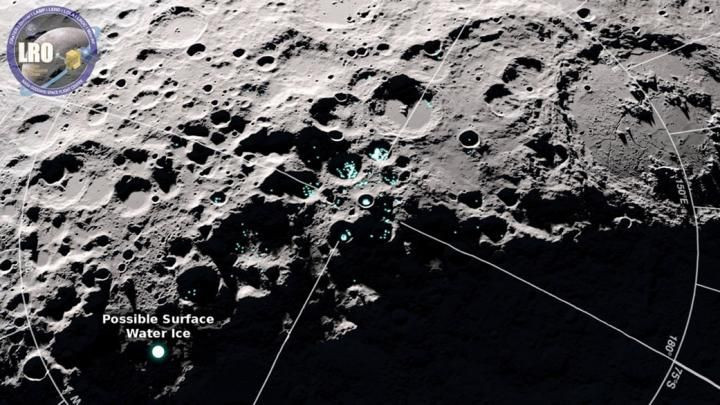NASA’s Moon Orbiter Finds Fresh Evidence Of Frost On Lunar Surface

It was more than 50 years ago that scientists first predicted that some land areas of the moon that don’t receive direct sunlight could have water ice, but it was only in 2009 that a NASA instrument aboard India’s Chandrayaan-1 lunar orbiter detected, for the first time, water on the surface of our only natural satellite. Another instrument on board that spacecraft found dozens of permanently darkened craters near the moon’s north pole that could contain up to 600 million tons of water ice, but that hasn’t been proven yet.
Across the moon, the south pole may not have such a large amount of solid ice, but it does have ice deposits in the form of frost, according to new evidence based on data collected by NASA’s Lunar Reconnaissance Orbiter (LRO), which has been orbiting the moon since 2009. Researchers analyzing the data combined the information about surface temperatures and the amount of light reflected by the surface at some craters near the pole.
“We found that the coldest places near the moon’s south pole are also the brightest places — brighter than we would expect from soil alone — and that might indicate the presence of surface frost,” Elizabeth Fisher, the lead author of a study about the new evidence, said in a statement Wednesday.
Read: NASA’s Mars Orbiter Finds More Evidence Of Water On The Red Planet
The moon has areas called cold traps — permanently dark regions either deep inside a crater or along a crater wall — that don’t receive direct sunlight, causing temperatures to remain below minus 260 degrees Fahrenheit (minus 163 degrees Celsius). If water ice is present in these cold traps, it could remain stable for billions of years.
For the study, Fisher and her colleagues concentrated on cold traps near the south pole that were also brighter than reflections from the soil alone. The frozen water they found in those areas is not thick sheets of ice, but patches of frost that is, in places, likely mixed in with the regolith —the surface layer of the moon, a mixture of soil, dust and small rocks.
The Diviner instrument on LRO was used for temperature readings, while the spacecraft’s Lunar Orbiter Laser Altimeter for measuring brightness.
“What has always been intriguing about the moon is that we expect to find ice wherever the temperatures are cold enough for ice, but that’s not quite what we see,” Matt Siegler, a researcher with the Planetary Science Institute in Dallas, Texas, and a co-author on the study, said in the statement.
Siegler added that the evidence found so far merits further investigation. For example, an important question is about the origin and age of lunar ice. If water on the moon was produced due to chemical reactions driven by solar wind, the ice is probably recent in origin. And that would mean the same process could occur elsewhere in the universe too. If on the other hand, the ice was deposited there by colliding comets or asteroids, lunar water deposits are ancient. It could also help us understand how Earth got its water.
The study, titled “Evidence for surface water ice in the lunar polar regions using reflectance measurements from the Lunar Orbiter Laser Altimeter and temperature measurements from the Diviner Lunar Radiometer Experiment,” was published in the journal Icarus.
© Copyright IBTimes 2025. All rights reserved.





















